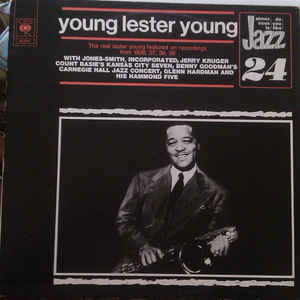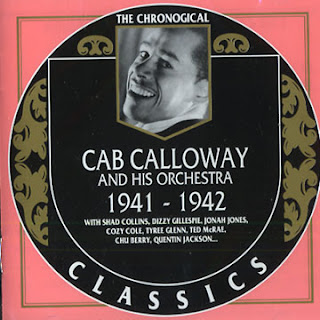Young Lester Young
EDIT: It's been brought to my attention that Lester Young is in fact not the saxophonist on the Jerry Kruger tracks. It is likely either Ernie Powell or, most likely, Kermit Scott. I have omitted that part of the article.
Side one starts Count Basie small groups with alternate takes of "Shoeshine Boy", "Dickie's Dream" (two of them) and "Lester Leaps In". "Shoeshine Boy" is from Young's first recording session with Jones-Smith, Incorporated. Basie's opening piano is similarly constructed to the other take. Same with Young's first chorus, where the hits on beat four on the bridge are not as well executed as on the final take. On the second chorus, he anticipates them beautifully. Walter Page on bass and Jo Jones on drums were the hardest grooving rhythm section in the business and they propel the rhythm forward.
 |
| The Lester Young Story, Vol.3 |
It's a wonderful performance, but then just ends abruptly. The second take is quicker and some of Clayton's licks from the first take appear again (the one where he is enclosing a note). Young's solo is equally good but different as is Wells'. The piano solo is omitted and instead there is a repeated riff that also ends the tune abruptly.
 |
| The Lester Young Story, Vol.4 |
There's an excerpt of "Honeysuckle Rose" from Benny Goodman's January 16, 1938 Carnegie Hall Concert. The band is Basie meets Goodman and begins with some collective riffing (not collective improvisation, but something like it) for two choruses. Young takes two choruses and his solo is just genius. It's taken at a medium-up tempo and Young's manipulation of the time feel is masterful. He likes to play repetitive two-note phrases that change every two beats, thus creating a half-note feel. Then he'll play some phrase that lays way behind the beat. He goes back and forth on these ideas often and it's really effective as one offsets the other. Feeling the half-note too at fast tempos would become part of the language.
Everything I heard did not prepare for me the six songs on side two with Glenn Hardman and his Hammond Five. These recordings were the first small group recordings for the Hammond organ (which came out in 1935), making them historically significant. Later Jimmy Smith, would use a fat, dark tone, but here Hartman seems to be content exploiting the novelty effects of the instruments and so it sometimes sounds like carnival or merry-go-round music! And then there's Lester Young taking solos on every track playing as is he were completely unaffected by his surroundings and this features some of his best work! I can't imagine what it sounded like to them at that time.
With trumpeter Lee Castaldo, the music is played as dixieland with Castaldo on the melody and Young playing some magical counter-melodies. They are backed by Freddie Green on guitar, Jo Jones on drums, and of course, Hardman on organ. Maybe it's because I like the unusual but Young's playing really makes these tracks very listenable. If not, then I imagine that these tracks would not see the light of day,
 |
| Excellent early compilation on streaming |
Young's background lines behind Castlanado are simply magical. His sound, choice of notes, phrasing, etc. remind me so much of Gerry Mulligan's groups. He must have heard the future in these Hardman sides. But a highlight in an album of highlights might be his performance on "Jazz Me Blues" where he plays killer breaks on each eight-bar section of the opening chorus. The first two are dirty---he plays the same note technique with false fingerings the first time and then the second break, he moves chromatically. It's all the more amazing considering Hardman's square feel alternating straight eighth-notes and ridiculous sounding double-time lines.
Young sounds especially inspired on this track, but all of the performances from that day in 1939 are excellent. He was born in 1909, so the older-style setting must have appealed to him. He sounds comfortable creating counter-melodies and he seems completely unfazed by the presence of the organ. Hearing him in this context, I can almost imagine him in his younger days, and his varied experiences with small pickup bands, vaudeville shows, and the like. Seems like he was quite the wanderer in his days before Basie, so he must have enjoyed the challenge of making music work no matter the situation. This is my rose-colored assessment, but then again, perhaps he enjoyed the unusual because he recognized a bit of himself in the situation.
The uptempo "Who?" is strong with a brush solo from Jones (he does the same on "China Boy") and, get ready for it, a solo for Freddie Greene! Yes, he takes a short chordal-type solo based off of his regular pattern and it might be the first I've ever heard from him.
This is a must have for any Lester Young fan, but is not national jazz news. Volume three and four of the Columbia two-fers from the 1970s' covers this material, but otherwise JSP's Count Basie compilation Away From Base from 2005 is the lone available CD with the Jerry Kruger and Glenn Hardman tracks.





According to Frank Buchmann-Moller (pp.99-100 of 'You Got to Be Original, Man!) "Careful listening shows that Lester is not present..-most of the musicians being members of the Benny Carter Orchestra. Lester was out of new York from April 10 t0 July 6 touring with the Basie band.
ReplyDeleteThank you for this. I never questioned given the recording given the label it was on, etc. In my description I did mention that he played like Coleman Hawkins----which I think Young was trying to get away from. I've since re-edited the article.
DeleteGreat post-thanks. Very interesting how musicians (and music) evolve. Bix Bixler, Jazz Lounge and Speakeasy.
ReplyDelete